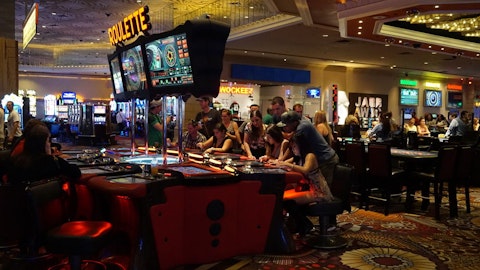Andrew Strelzik: Hey, good afternoon. Maybe I’ll just round out some of the near-term sales questions here. I’m curious if you could parse out, are you seeing any change in spend levels either on reloads or in F&B that may be or if you’re not seeing that, maybe that contributes to maybe some of your — confidence and can you just comment on that would be great.
Mike Quartieri: Yes. I’ll start and then I’ll let Chris chime in if he wants to add anything else. The one thing we are seeing and highlighted this before, is as Special Events become a bigger component of the business and we are seeing that return back to 2019 levels. That piece of business skews higher to the Food and Beverage side of the business than it does to the Amusement. So we are seeing an uptick in Food and Beverage as a percentage of the overall revenues. As you know that Food and Beverage revenue does have a slightly lower gross margin than Amusement. So just the pure mix shift will put a little bit of pressure on the overall margin on a status quo basis. But given the operational team that we have in place and the things that Tony are doing, we’re more than offsetting that impact in our numbers.
Andrew Strelzik: Got it. Okay. That’s helpful. Thank you. And then, maybe a bigger picture, longer-term one. You talked about some of the operational improvements that you’re implementing in this next phase, potentially unlocking this new hospitality model, which is I guess, you said more like a longer-term opportunity. Can you just describe just how you envision that playing out? I mean what is the hospitality model in your mind look like over time, what are you trying to achieve?
Chris Morris: Yes. Sure, Andrew. I’d be happy to do that. What I’ll do is I’ll give you just a general sense, I’ll give you more color on how we’re thinking about it. But certainly, on May 16, during the Investor Day, this is an area where we’ll spend some considerable time on. And so you’ll be able to — I’ll touch it again on May 16, you’ll hear directly from our Chief Operating Officer, and you’ll hear from our Chief Information Officer. But essentially, we have very large assets, so 30,000 to 40,000 square feet, in some cases, 50,000 square feet, and we do a considerable amount of volume in a very short period of time. And so when you think about the hospitality model, I think in our business, we have to think about it certainly differently than what a restaurant would have to.
And so we’ve really challenged ourselves how do we make sure that we create an environment where we’re able to manage guest flow, all that traffic through our center and all of our different venues as efficiently as possible and in a way where we’re catering to the guest needs every step of the way. And so we intend to work closely with our operators and with our head of technology on developing proprietary tools to be able to stay engaged with the guest throughout the entire guest journey. And so again, we’ll walk you through this in a lot more details. This is work that we were already starting on the Main Event side that we’ve carried over into Dave & Busters. But it’s that intersection of the human service model and the technology model where we’re maniacally focused on enabling the hospitality experience.
And so we think that there’s just tremendous upside as we develop this. And we’re able to stay more engaged with the guests throughout every step of that journey, then that gives us the advantage of being able to collect a tremendous amount of data on those particular guests to be able to tailorize our service approach just to meet their specific needs. So it will help us on managing throughput that will help us on growing average guest check. It will help us on building more engagement with our guests, which should lead to more loyalty, more frequency and an overall better, enhanced experience. So we have an entire plan that’s kind of staged year-by-year on how all this is going to unfold.
Operator: . Our next question comes from Brian Vaccaro from Raymond James. Please go ahead.
Brian Vaccaro: Hi. Thanks and good evening. Just a quick clarification on the quarter-to-date. It sounds like qualitatively; you don’t believe you’ve seen a change in behavior or that the underlying is relatively stable. Correct me if I heard that incorrectly. But does that mean that your comps versus ’19 were similar in February and March at each brand?
Mike Quartieri: The overall trend in the business that we saw versus ’19 continues and if there was anything, I would say, of note, of any 1 of the 2 brands, dramatically underperforming or overperforming that was driving the overall results, we would specifically call that out to you guys.
Brian Vaccaro: Okay. And then you mentioned spring break shifts. In your view, how do those shifts impact sales in March and April, does that help March and hurt April or maybe it’s the other way around?
Chris Morris: Yes, I can take that. So a couple of things. So I mentioned that it’s really tough to get a beat on sales right now. And it’s a combination of the timing of calendar mismatches as well as lapping the return to business coming out of omicron last year. And so as a result, it’s just created a lot of volatilities in the numbers week to week. There are certain spring breaks that are different all over the country. And so there are some markets where April is going to benefit, and March was negative. And so once we get through that period of time, we’re going to have a much better feel for what the underlying trend is in the business. So it’s just a little choppy right now. It’s tough to get a read on it. And that’s the disadvantage of looking at our business over a very short period of time.
And so we’d like to keep our focus more on the longer-term aspect. We’ve just pulled together two very strong quarters. We feel very good about our performance. We still feel very good about the underlying trends in the business. We think coming out of this period of mismatch that we’re going to continue to grow the business, but time will tell. We’ll be in a better position in our Investor Day on May 16 because we’ll be over that period of mismatch. And if there’s something that’s material that we should be reporting, then we can use that as an opportunity to update you. But our plan as of right now, we believe that the business is going to work its way through this mismatch and we’re going to get back to growing the business the way that we have been.
We take a lot of comfort that we continue to do really well against 2019. And so we think that’s still a measure of health of this business. And so that gives us confidence as well.
Mike Quartieri: Plus, I’ll just add to the upside. As we continue to see our Special Event business drive, that just provides more fuel for, I would say, any type of protection if there’s a downturn from a walk-in perspective, and it just provides further fuel, if there’s not, for the business to expand even further.
Operator: Our next question comes from Jake Bartlett from Truist Securities. Please go ahead.
Jake Bartlett: Great. Thanks for taking my questions. Unfortunately, I’m going to start with another one about the first quarter trends and I apologize for that. But I think one thing that investors are looking at is April of last year was very strong. I think it was 21% comp. I think February was flat. March was up 12%. So it looks like April is difficult. So we kind of wonder where it goes from here, that typical compare. My question is, is the marketing plan similar? So I think April was really boosted by the Eat & Play coming back by kind of peaking the peak with advertising. Now you have the Slam Dunk meal. Should we think about what you have planned for April and what you did last year is similar so that we shouldn’t see kind of — it’s not as difficult a compare to speak as one might think otherwise?
Chris Morris: Yes, I think that’s very fair. The structure of the deal is essentially the same structure. So Eat & Play Combo, as I said in my prepared remarks, and if you’ve been following the company for a long period of time, you already know this, Eat & Play Combo is that steady Eddie value-driven promotion that has worked well for the brand over time when used correctly. What we’ve learned, not only in our own research, but going back and looking at how it’s performed over the years is that, that message can — there’s a certain amount of fatigue that comes when the company uses that message over and over again. And so the message of Eat & Play Combo is better served whenever we believe it’s better served when we do it once a year.
But we still wanted to take advantage of the structure of that combining food and entertainment for a great value. And so what you’re seeing us do this quarter is just simply introduce that with a fresh seasonal-driven message. And at the same time, leveraging the strength of the basketball season and continue to build awareness around all the great assets that we have on the watch side of our business, which we know, again, from all of our research that there’s a big opportunity to build more awareness around that side of the business. But the structure of the deal is essentially the same. When we looked at the results last quarter, when we looked at the results in April last year of Eat & Play Combo, we actually don’t see that big of a difference between how it performed in April versus how it performed in November.
The business overall did much better in April, but that was also a period of time when we were coming out of omicron, there was a lot of pent-up demand, and we believe that, that really fueled our business. And so we don’t think the promotion was as big of a driver last year. But we’re keeping an eye on it week-to-week, and we always have the ability to pivot, if necessary. But as of right now, that’s our plan. We feel good about it. And again, we’ll know more next time we give you an update.





